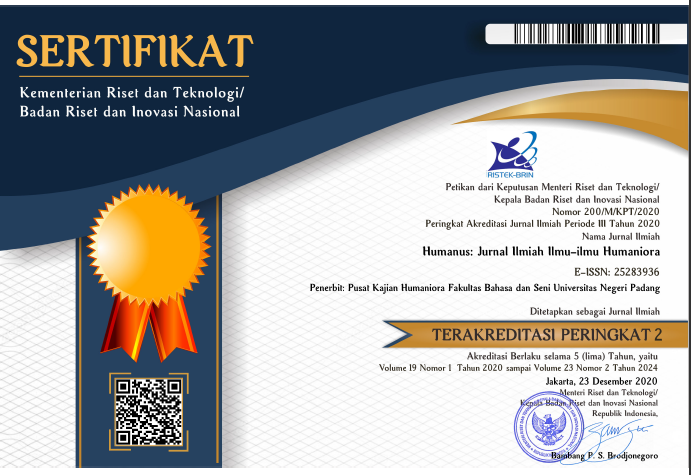Randai as a Social Representation Minangkabau Society of the Past
 ), Marzam Marzam(2), Mohd. Effindi Samsudin(3),
), Marzam Marzam(2), Mohd. Effindi Samsudin(3), (1) FBS Universitas Negeri Padang
(2) marzam1962@fbs.unp.ac.id
(3) Universitas Malaya
 Corresponding Author
Corresponding Author
Copyright (c) 2020 Humanus
DOI : https://doi.org/10.24036/humanus.v19i1.106302
Full Text:
 Language : en
Language : en
Abstract
References
Annisa, A. I., & Indiatmoko, B. (2017). Representasi Sistem Pernikahan Budaya Yogya dalam Novel Perempuan Jogja Karya Achmad Munif. Seloka: Jurnal Pendidikan Bahasa Dan Sastra Indonesia, 6(1), 74-84.
Fahmiati, M., & Indrayuda, I. (2019). The Representation of Women in Galombang Creations Dance Produced by Syofiani Studio Padang City. In Seventh International Conference on Languages and Arts (ICLA 2018). Atlantis Press.
Hidayat, D. (2014). Representasi Nemui-Nyimah sebagai Nilai-Nilai Kearifan Lokal Lampung; Perspektif Public Relations Multikultur. Jurnal Ilmu Komunikasi Universitas Riau. ISSN, 90-102.
Hidayat, Rahmat, Indrayuda Indrayuda, and Syahrel Syahrel. "Upaya penggalakan randai dan nagari ampu." Jurnal Sendratasik 2, no. 1 (2013): 75-85.
Indrayuda. (2017). “The Domination of Female in Galombang Dance: Between Traditional Idealism and Use to Performing Arts Market,” Jurnal Harmonia 17 (2).
Islami, M. N. (2014). Representasi Masyarakat Urban Jakarta dalam Film Jakarta Maghrib. Jurnal Commonline Departemen Komunikasi, 2(2), 84-95.
Latiff, Z.A. & Jonathan, D. A. D. (2014) To “randai” or not to “randai”. Asian Theatre Journal. 31(2), 545-557.
Putri, M. M., Desfiarni, D., & Darmawati, D. (2015). Pelestarian Kesenian Randai di Sanggar Minang Saiyo Desa Sijantang Kota Sawahlunto. Jurnal Sendratasik, 4(1), 37-46.
Rusydi. (2009). Randai “ Teater Rakyat Sumatera Barat”. Padang: Kantor Dinas Pendidikan Kecamatan Pauh.
Sari, F. F., & Indrayuda, I. (2019). Revitalization of Dance and Values Contained in Dance Balota in Kenagarian Sungai Bukik Baiah District 9 Lasi. In Seventh International Conference on Languages and Arts (ICLA 2018). Atlantis Press.
Syuriadi, H., & Hasanuddin, W. S. (2014). Nilai-nilai Pendidikan dalam Teks Cerita Randai “ Malangga Sumpah” Karya Lukman Bustami Grup Randai Bintang Tampalo Kenagarian Padang Laweh Kabupaten Sijunjung. Bahasa, Sastra, dan Pembelajaran, 2(2).
 Article Metrics
Article Metrics
 Abstract Views : 580 times
Abstract Views : 580 times
 PDF Downloaded : 225 times
PDF Downloaded : 225 times
Refbacks
- There are currently no refbacks.
Copyright (c) 2020 Humanus

This work is licensed under a Creative Commons Attribution-NonCommercial 4.0 International License.










